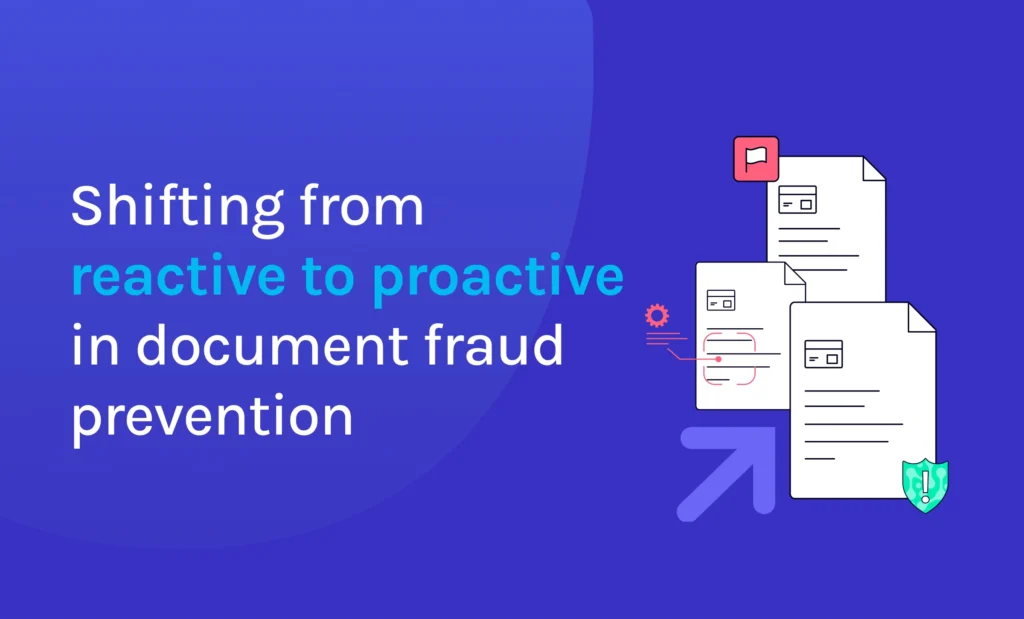This website uses cookies so that we can provide you with the best user experience possible. Cookie information is stored in your browser and performs functions such as recognising you when you return to our website and helping our team to understand which sections of the website you find most interesting and useful.
Shifting from reactive to proactive in document fraud prevention

Every lender faces fraud, but not every case of potential document fraud is black-and-white, making it particularly difficult to identify and prevent. Lenders receive documents in many forms—such as e-PDFs, scans, and images—each with its own set of challenges and potential methods of tampering.
Effectively preventing fraud across document types requires a mix of technology, process and analysis to accurately detect signals of potential fraud and investigate documents that may be illegitimate. Understanding fraud signals and how to address them based on organizational risk models is critical to making informed lending decisions.
Technology’s role in proactive fraud detection
One of the primary challenges in fraud detection lies in organizations’ reliance on manually reviewing documents for signs of fraud. This process can be highly error-prone due to the advancing technologies and practices used by fraudsters to alter or generate documents, making tampering invisible to the naked eye. This susceptibility to error often forces financial institutions to react to cases of fraud after the fact rather than proactively preventing them.
With fraud detection software like Ocrolus Detect, lenders gain valuable insights and fraud signals for each loan application document. Using pattern recognition, advanced machine learning and AI, Detect digs into the virtual guts of a document to identify signs of tampering, such as inconsistencies in fonts or formatting. It can even flag documents created from templates based on the digital fingerprints left behind by tools like paystub generators. Each signal of potential fraud is summarized within the Detect Authenticity Score, providing lenders with a single score of 0-100, weighing the context of what was tampered with and our confidence in the fraud signal.
Setting and adjusting thresholds for risk
Each organization has its threshold for risk when it comes to fraud, and effective fraud mitigation can only happen with strong systems, policies and operations in place. While technology can provide signals and context around potential signs of fraud, financial institutions must also have processes to leverage that information.
Processes could be as simple as using the Detect Authenticity Score as a threshold for further review. For example, a document with a moderate score (between 50 and 79) may be legitimate despite some concerns. More conservative organizations may elect to pass on any document that scores below 80 for analyst review, while another’s threshold may be closer to 70.
Regardless of the specific threshold set, organizations should continuously gather and review borrower patterns and related outcomes to enhance detection practices, adjust their thresholds, and improve analyst review processes for more confident, efficient decision-making.
New signals available in Ocrolus Detect
We recently made several enhancements to our Detect software to provide additional context and new positive and negative fraud signals for lenders working to investigate and analyze fraud risk. New signals available in Detect include:
- Suspicious address detection—Addresses are captured and validated for accuracy, and suspicious addresses are flagged. While this signal does not confirm a document’s authenticity, fraud analysts can verify the address and ensure the entry was not made in error or due to accidental auto-correction.
- Suspected template detection: Detect identifies e-PDFs or scans created using software from template generation sites that are likely to be fraudulent. With this information, fraud analysts can quickly flag the document and prevent unnecessary risk.
- Bank fingerprint: This signal provides additional confidence that a document is authentic by verifying the document fingerprint in e-PDFs from top banks when no other signals are found. The bank fingerprint signal indicates that the document is neither tampered with nor generated and is only displayed when no other negative signals are present. With this added confidence in authenticity, documents with a fingerprint match are automatically assigned a Detect Authenticity Score of 95, saving lenders time and reassuring them that the document is legitimate.
Armed with these signals and the simplified Detect Authenticity Score, lenders can easily and efficiently identify documents that have a low risk of fraud, those that can be flagged as illegitimate and others that require further analysis.
Book a demo today if you want to learn more about how intelligent document automation and fraud detection can help your team more effectively mitigate fraud.
Key Takeaways:
- Preventing fraud in lending requires a mix of technology, process and analysis to detect signals of potential fraud and investigate illegitimate documents accurately.
- Intelligent fraud detection technology can provide valuable information on documents’ authenticity, enabling lenders to easily and efficiently identify documents within acceptable thresholds and those requiring further analysis.
- Organizations must have robust systems, policies, and processes to effectively leverage the signals and context from AI-driven fraud detection to address potential fraud based on their risk thresholds.





